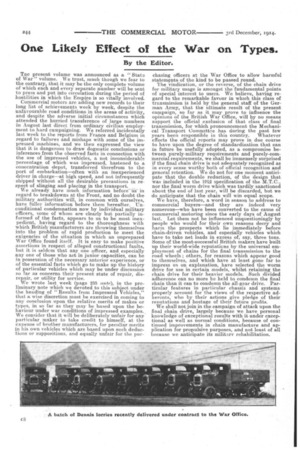One Likely Effect of the War on Types.
Page 2

If you've noticed an error in this article please click here to report it so we can fix it.
By the Editor.
The present volume was announced as a "State of War" volume. We trust, much though we fear to the contrary, that it may be the only complete volume of which each and every separate number will be sent to press and put into circulation during the period of hostilities in which the Empire is so vitally involved. Commercial motors are adding new records to their long list of achievements week by week, despite the unfavourable road conditions in the areas of activity, and despite the adverse initial circumstances which attended the hurried transference of large numbers in August last direct from ordinary civilian employment to hard campaigning. We referred incidentally last week to the reports from France and Belgium in regard to failures and mishaps with some of the impressed machines, and we then expressed the view that it is dangerous to draw dogmatic conclusions or inferences from the observed facts in connection with the use of impressed vehicles, a not inconsiderable percentage of which was impressed, hastened to a concentration depot, transferred therefrom to the port of embarkation—often with an inexperienced driver in charge—at high speed, and not infrequently shipped without all the desirable precautions in respect of slinging and placing in the transport.
We already have much information before-1mm regard to breakdowns at the Front, and no doubt the military authorities will, in common with ourselves, have fuller information before them hereafter. Unconditional condemnation now by individual military officers, some of whom are clearly but partially informed of the facts, appears to us to be most inexpedient, having regard to the thoroughness with which British manufacturers are throwing themselves into the problem of rapid production to meet the exigencies of the situation in which an unprepared War Office found itself. Tt is easy to make positive assertions in respect of alleged constructional faults, but it is seldom that any one officer, and especially any one of those who act in junior capacities, can be m possession of the necessary anterior experience, or of the essential facts which go to make up the history of particular vehicles which may be under discussion so far as concerns their present state of repair, disrepair, or utility for service.
We wrote last week (page 235 ante), in the preliminary note which we devoted to this subject under the heading of "Results from Impressed Vehicles," that a wise discretion must be exercised in coming to any conclusion upon the relative merits of makes or types, in so far as they may be based upon the behaviour under war conditions of impressed examples., We consider that it will be deliberately unfair for any particular maker to take credit to himself, at the expense of brother manufacturers, for peculiar merits in his own vehicles which are based upon such deductions or suppositions, and equally unfair for the pur
chasing officers at the War Office to allow harmful statements of the kind to be passed round.
The vindication, or the reverse, of the chain drive for military usage is amongst the fundamental points of special interest to users. We believe, having regard to the remarkable favour in which this class of transmission is held by the general staff of the German Army, that the ultimate result of the present campaign, BO far as it may prove to influence the opinions of the British War Office, will by no means support the official exclusicn of that class of final transmission, for which pronouncement the Mechanical Transport Committee has during the past few years been responsible in this country. Whatever effects the official reports may prove in due course to have upon the degree of standardization that can in future be usefully adopted, as a compromise between purely-military requirements and purely-commercial requirements, we shall be immensely surprised if the final chain drive is not adequately recognized as in every sense worthy both of official recognition and general retention. We do not for one moment anticipate that the double reduction, of the design that was included in the 1912 specification of the M.T.C., nor the final worm drive which was tardily sanctioned about the end of last year, will be discarded, but we do anticipate that the chain will win equal scope.
We have, therefore, a word in season to address to commercial buyers—and they are indeed very numerous—who have been converted to the cause of commercial motoring since the early days of August last. Let them not be influenced unquestioningly by people who would for their own reasons decry and harm the prospects which lie immediately before chain-driven vehicles, and especially vehicles which have to take net loads in excess of, say, three tons. Some of the most-successful British makers have built up their world-wide reputaticns by the universal employment of chains for the final transmission to the road wheels ; others, for reasons which appear good to themselves, and which have at least gone far to impress us on explanation, have selected the worm drive for use in certain models, whilst retaining the chain drive for their heavier models. Such divided adherence can no more be held to condemn the final chain than it can to condemn the all-gear drive. Particular features in particular chassis and systems properly account for the views of the respective adherents, who by their actions give pledge of their reputations and hostage of their future profits.
We shall not join in the campaign of attack upon the final chain drive, largely because we have personal knowledge of exceptional results with it under exceptional as well as normal conditions, because of continued improvements in chain manufacture and application for propulsive purposes, and not least of all because we anticipate its military rehabilitation.




















